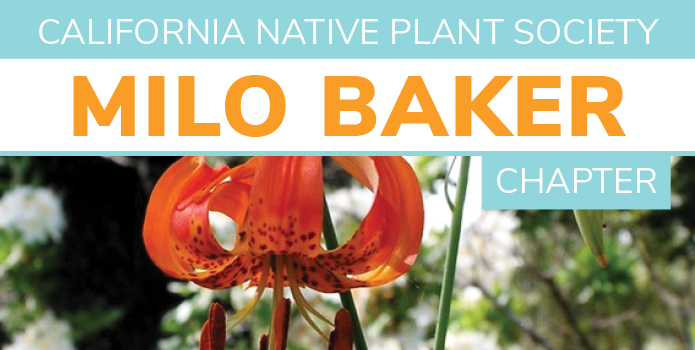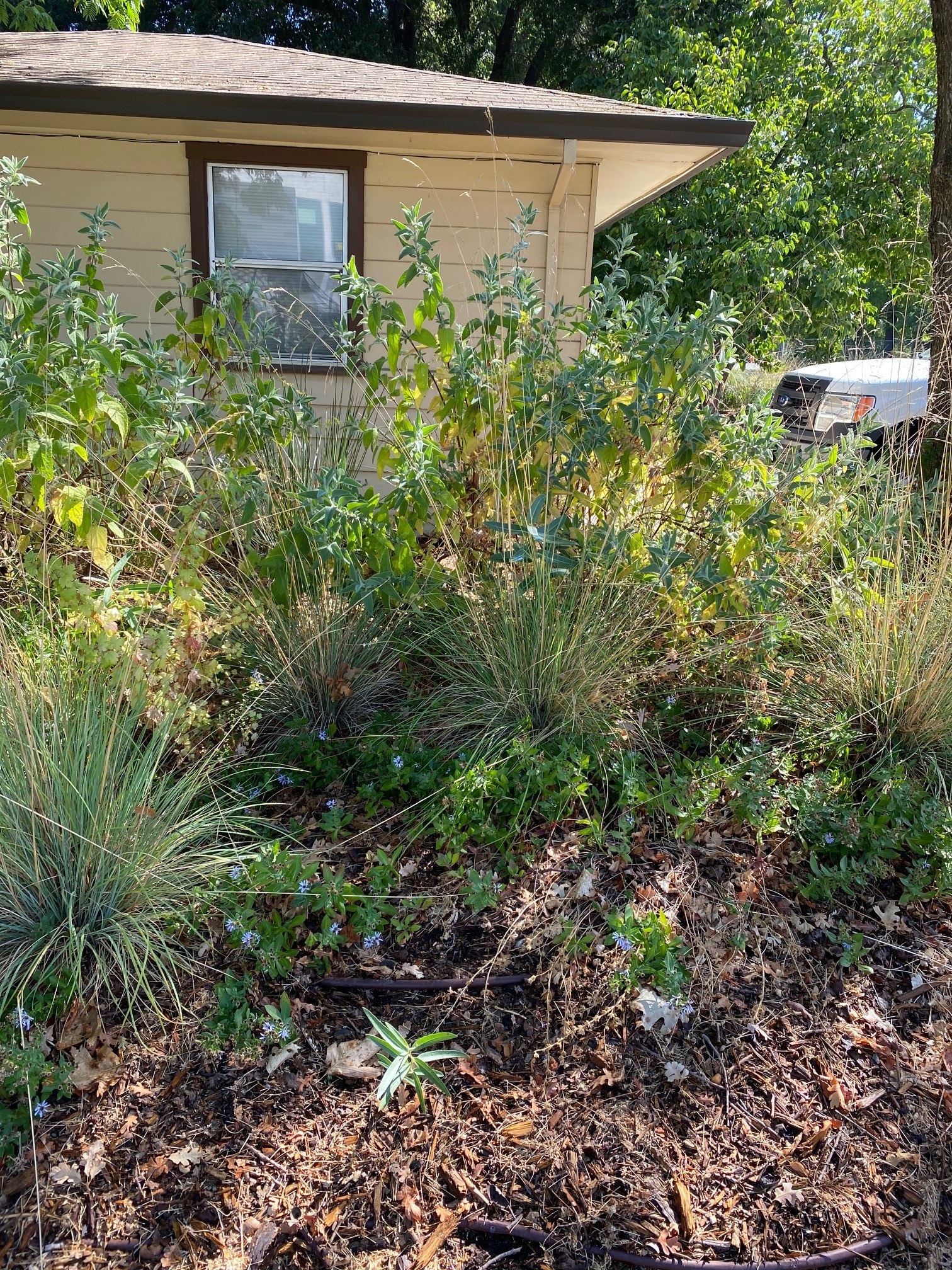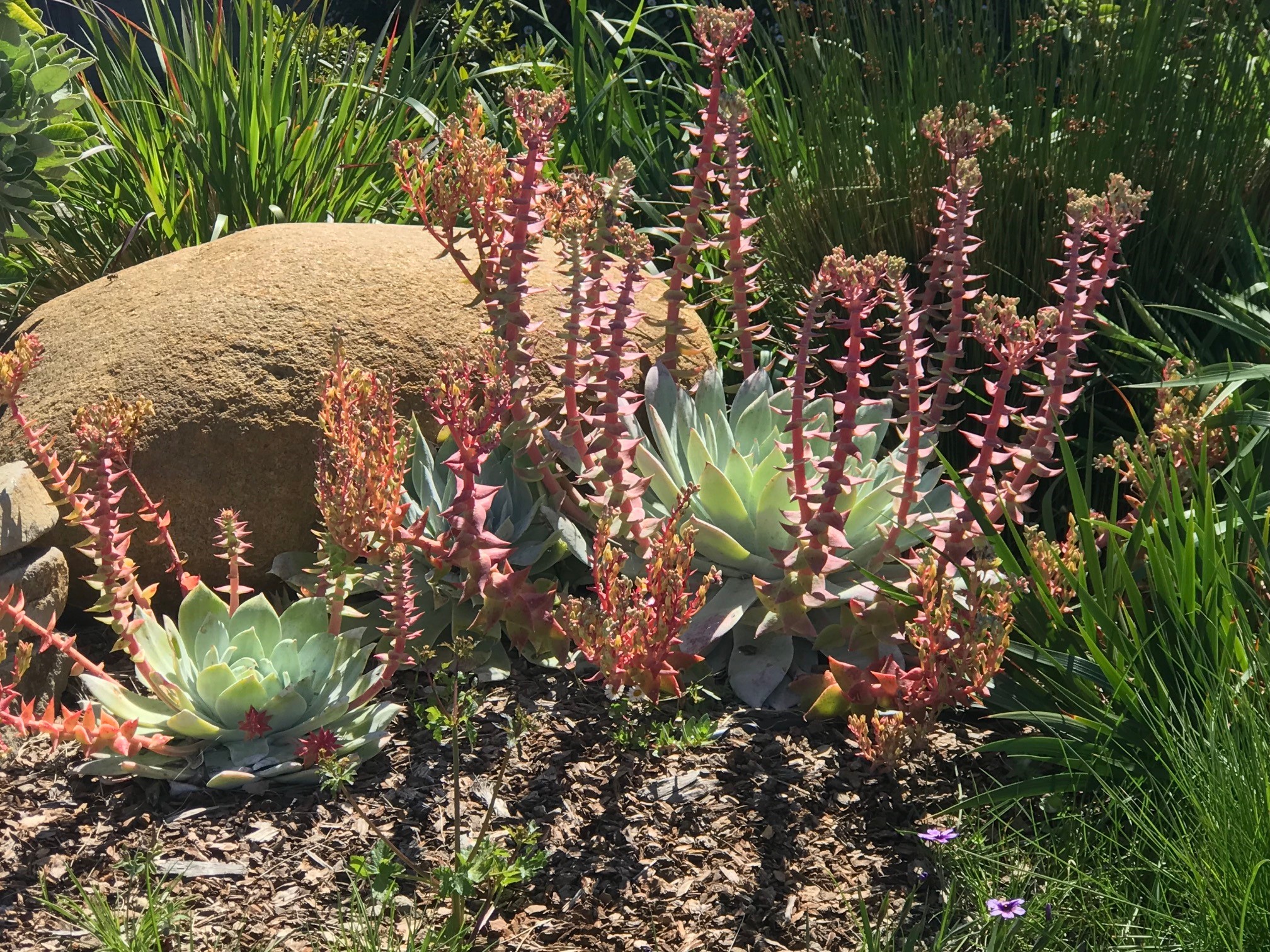|
California Native Plant Society
 |
| |
|
|
| In this issue: Speaker Series, Message From the President, Conservation Update, Fall Plant Sale, Volunteer Opportunities, In the October Garden, and Membership Housekeeping. |
| Conserving and Restoring California Native Plants: The Belowground Connection |
Chelsea Carey, PhD, Point Blue
Speaker Series, October 20, 2020 at 7:30pm via ZOOM |
Zoom link at milobaker.cnps.org
Dr. Chelsea Carey is the Working Lands Research Director and Principal Soil Ecologist at Point Blue Conservation Science. In her role, Dr. Carey develops and leads priority research projects and partnerships that will help inform rangeland management across the state. Her current research generally focuses on characterizing soil properties that are relevant to rangeland soil health and climate change mitigation, determining how management influences these properties across space and time, and identifying ways that explicit consideration of the soil can improve success of conservation practices like riparian restoration. Prior to joining Point Blue, Dr. Carey received her PhD from the University of California Merced’s Environmental Systems Program and spent time as a postdoctoral scholar at the University of California Riverside. Over the past decade, Dr. Carey has conducted research on plant-soil interactions across many systems, from California's grasslands to giant sequoia groves in the Sierra Nevada.
|
|
|
| |
| Message from the Chapter President |
As October rolls around our attention turns to fall planting. First up, preparing the soil. Mine is hard as a rock. Next is laying out and connecting a watering system. Only a little water will make my soil workable. My goal is to have those plant sale specimens in the ground within a few days of bringing them home. A lofty goal.
A new season of speakers has also begun. In September the chapter hosted Jason Mills from the Sonoma Ecology Center speaking about the impact of invasive plants on ecosystems. It was our first virtual meeting, not nearly as fun as our old-style get togethers but just as informative. Jason had a slide show that accompanied his talk with many pretty photos as well as some of the dreaded weeds. One advantage of the Zoom virtual sessions is that they can be recorded and members can view them later. We had a good turn out- 50 participants! If you missed it, you will be able to view it by going to cnps.org and clicking on the following link: Jason Mill’s Presentation. Be sure to notice all the other programs from other chapters that are also available to see. This is another surprise bonus of virtual programming!
In early October our volunteers will be getting ready for the fall plant sale. This is our biggest fundraiser of the year. It won’t be like previous sales but it’s important to adapt to new realities, at least this year. As soon as possible we will go back to in person events. In the meantime you will have to buy online and pick up your plants at the nursery by appointment. Formembers, the sale opens on October 7, so be sure to watch for an email with the link to the sale.
There have been other unforeseen consequences of the pandemic. One is a slow down in membership renewals. Our state administration (CNPS) has made substantial investments in conservation advocacy and field work. There is fantastic momentum building to monitor and comment on new development as well as renewable energy projects and legislative action. The field botanists are also diligently monitoring and mapping rare plants and plant communities as well as collecting seed for future generations. Please renew your membership so that this important work can continue all over California.
Please also keep an eye on our website (milobaker.cnps.org). Natasha Granoff has diligently kept it up to date so check often to see changes in our chapter. We all try to keep all the details there so if you have any questions about events or connections, the information should be easy to find.
And finally, preparations are beginning for the May 2021 Eco-Friendly Garden Tour. If you have a garden you would like to have on the tour, please contact Betty Young. Once the plant sale is over, I know she will be starting to think about spring. Hopefully we will all be outside, unmasked, enjoying the gardens.
Wendy Smit,
Chapter President |
|
| |
| Milo Baker Conservation Actions Summer 2020 |
It’s hard to think long-term when so much is happening in the short-term: the pandemic, the fires, the election. However, it’s important to work towards a future that is fighting extinction and conserving wildlands. So, working towards that long-term goal, Sean McNeil and I responded to two County actions over the summer. The first was a letter in response to the proposed Vineyard Erosion and Sediment Control Ordinance (VESCO). This ordinance has some guidance for landowners looking to develop a vineyard or an orchard, but the applicant can just fill out the application and get a permit without any feedback from the public or even the staff at the Agricultural Commissioner’s Office. We stated that Sonoma County should be the lead agency to ensure that the environmental impacts in the development of agricultural projects are appropriately reviewed and all impacts either removed or mitigated. We stated that in a County as diverse as Sonoma County many projects have unique site characteristics that would benefit from discretionary review where site specific parameters could help the VESCO applicant protect the environment while developing their agricultural property. That’s a lot of jargon to state that the current ministerial permits do not protect aquatic resources and plant and wildlife habitats. We went into detail on some solutions to their proposed ordinance.
The second long-term goal was a letter to the County requesting to be one of the stakeholders in the creation of the Sonoma County Habitat Conservation Plan/Natural Community Conservation Plan (HCP/NCCP). If done well, the creation of an HCP/NCCP is a good tool for long term conservation of special status plants. We want to make sure that the best,occupied habitat is protected and that the development is only allowed in the most marginal of habitats. Furthermore, the development of the marginal habitats will provide the needed funding to ensure the protection and care of the high-quality rare plant habitats. Ultimately the plan will identify measures to reduce the impact on endangered species and reconcile the goals of species protection and economic development. While HCP/NCCP will streamline the process for development, it will more importantly provide a clear path for the conservation of federal and State listed species. We feel strongly that it is better to be involved early and try to ensure that someone speaks for the plants and their habitat and we look forward to our involvement in this County project.
On the State level, many projects are being commented on by hard working chapter members across the state. With so many letters being written a pattern has shown through, many of the transgressions on proposed projects are being repeated. As a result, the State staff will be creating a tool kit that will be a repository for letters that have already been written and can be drawn upon for all chapters when writing comment letters on a specific project. Once that is up and running it will be shared with our members and hopefully make our jobs of responding to impacts from development projects easier.
These long-term goals are just starting but we’re hoping that by changing the planning in our County our sensitive vegetation communities will be protected for a long, long time.
Trish Tatarian
Conservation Co-Chair, Director at Large |
|
|
|
| FALL IS PLANTING SEASON IN CALIFORNIA |
|
| Online Plant Sale Update |
It's almost here. Our traditional Fall Plant Sale will break with tradition due to Covid 19. Check the September Newsletter for Liz’s great article about the sale. See a complete list of the plants we will offer by following this link to our Plant List PDF.
Members who receive their newsletter electronically, (if you are reading this you probably do) will receive an email on October 7 with a link to the online sale website. The site will not open to the public until 10/9. So you will have the first choice of plants, but be sure to order on 10/7 or 10/8 for best selection. We sold out quickly in the spring.
If you are getting this notice another way, and don’t get the e-newsletter, and you are a member, write to cnpsmbmembership@gmail.com and ask to get newsletters electronically. Otherwise, on October 9 go to the CNPS Milo Baker HomePage,www.milobaker.cnps.org for a link to the sale.
Your order will be ready for pick up at the nursery, the next day. Make an appointment to pick up as you check out on the website. If you don’t have access to a computer, call Betty Young, 707-695-4257. She will enter your order for you.
Betty Young, Nursery and Garden Tour Chair
|
|
 |
Volunteer Opportunity
Sonoma County Living Learning Landscapes first Friday of the month at 10am meet 1808 Albany Drive Santa Rosa email or call April Owens 707.331.2070 aprilleeowens@gmail.com.
Bring: hand pruners if you have them and a mask of course.
Image: Native Plant Garden at Santa Rosa Junior College, Courtesy of April Owens. |
|
 |
Volunteer Opportunity
Invasive Ice Plant Removal Wednesdays 9:30-11:30 at Doran Beach. Text Invasive Plant Chair Jan 707.569.4724 to find out where they are working let her know you are coming!
Image: Piles of ice plant at Doran Beach Park, Courtesy of Jan Lochner. |
|
 |
Plant Walks/Field Trips
While our Plant Walks and Field Trips are on hold in 2020, we hope to be back in the great outdoors in 2021. Sign up for Email Alerts for our Plant Walks and Field Trips. Contact Ruthie Saia: ruthiegardengirl@gmail.com.
Image: Doug Wirtz at Jepson Prairie Preserve, May 2019, Courtesy of Ruthie Saia. |
|
|
|
 |
Dudleya pulverulenta (Chalk Dudleya).
Photo credit: April Owens |
 |
| Mimulus ‘Marigold’ (Monkeyflower), Salvia clevelandii (Cleveland’s Sage) and Solidago calfornica (Goldenrod) from the CNPS Milo Baker plant sale last year. Photo credit: April Owens |
| . |
In the October Garden
This is the time of year for planting and maintenance. As the weather starts to cool I am more inspired to get out in the garden and get after the summer growth. Especially if you live in the WUI (Wildland Urban Interface), it is time to take a good look at your garden with fire in mind.
Think of your garden in zones from buildings: 0-5 ft, 5-30 ft, 30-100 ft- as well as general maintenance. Are fallen leaves cleaned up and in the landscape bin or composted far from buildings? Are any plants failing or overly woody in the landscape? Is the wood pile far from the home? Also garbage and recycling bins!
I focus from the house out with the most important area being the 0-5 zone (well, home hardening is the most important area!). It is recommended that this area is completely void of plants so that embers can not ignite your home. I use decorative rock, containers with low plants, and succulents in this zone. If you do have plants in this zone be sure they are well hydrated free of any woody material.
The 5-30 zone is for well tended lower plants and groundcovers - the key is maintaining them so they are free of woody materials. Epilobium canum (California fuchsia), Baccharis pilularis ‘Twin Peaks’ or ‘Pigeon Point’ (Coyote Brush) are some good plants for this zone. Be sure groups of plants have wide areas between them like pathways. I usually use 3-4’ wide pathways with crushed rock or less than 2” Arbor Mulch. In this zone you can have some taller plants like Heteromeles arbutifolia (Toyon) and Frangula californica (Coffeeberry) but make sure there is a good distance between their groupings depending on how large your yard is.
The 30-100 foot zone is what I call the biodiversity zone where larger islands of plants with mulched breaks between is allowed. Here you can have beautiful masses of California native shrubs (or hedgerows). Try to place the tallest plants in the middle and shorter at the edges. There are ratios recommended for the spacing between plants - usually 2x the height of the tallest plant in the hedgerow to the next grouping.
Fire-wise landscaping has caused a big shift in the way I design and takes a lot of creativity to ensure habitat in your garden while keeping it well maintained. Have I said maintenance enough times? Well it is the key as there are no fire safe plants. A firefighter told me once that you need to think of the landscape as slowing down a fire from 100’ towards your home. Great advice.
Time to clear out the old woody plants and make room for some new ones from our plant sale this month!
Please send us your garden observations and photos of how you live and garden with California native plants. Let us know if we can feature your California native garden in our newsletter and social media for future months. Send us an email to cnpsmilobakerhorticulture@gmail.com or give April a call at 707.331.2070. We will be happy to come take some photos of your garden and have a Covid-19 safe tour. Happy Gardening!
The CNPS Milo Baker Horticulture Committee
|
|
|
Membership Housekeeping: Email Preferences
Whether you have just joined, are renewing your membership, or haven’t looked into the details of your membership in a long time, please update your mailing preferences to make sure you are subscribed to receive email from our local chapter by 1) going to www.CNPS.org, 2) logging in to your membership profile to manage your email preferences, and 3) checking the subscribe box!
On that same page under the section “Email Interests,” you can also subscribe (receive emails) on additional topics such as your Local Chapter News.
Please note that if you don’t check the box, then by law we cannot email you notifications about our events and such, for example online plant sales and virtual presentations, unless you contact us to explicitly give us permission to email you for each specific notification.
|
|
|
| 2020-2021 Milo Baker Board Members |
|
President
|
Wendy Smit |
707-481-3765 |
wsmit8000@gmail.com |
| Past President: |
Leia Giambastiani |
707-322-6722 |
leiagia@gmail.com |
| Vice President: |
Liz Parsons |
707-833-2063 |
lizpar8993@aol.com |
| Secretary: |
Kerry Wininger |
707-888-5616 |
kerrywininger@gmail.com |
| Treasurer: |
Jim Piercy |
707-539-3441 |
terrapenecarolinamajor@yahoo.com |
| Conservation Chair: |
Sean McNeil |
707-480-2965 |
seanmcneil0@gmail.com |
| Director at Large: |
Trish Tatarian |
|
Trishtatarian@gmail.com |
| Director at Large: |
Cody Ender |
|
codyender@gmail.com |
| Director at Large: |
Natasha Granoff |
|
Njgranoff@comcast.com |
| Plant Walks: |
Ruthie Saia |
707-322-7462 |
ruthiegardengirl@gmail.com |
| Horticulture Chair: |
April Owens |
707-331-2070 |
cnpsmilobakerhorticulture@gmail.com |
| Hospitality: |
Karen Thompson |
415-786-6788 |
ket@sonic.net |
| Hospitality: |
Liz Parsons |
707-833-2063 |
lizpar8993@aol.com |
| Invasive Plant Chair: |
Jan Lochner |
707-569-4724 |
4lochs@comcast.net |
| Membership: |
Susan Dean |
|
cnpsmbmembership@gmail.com |
| Newsletter Editor: |
Caprice Disbrow |
707-322-5119 |
cnpsmbnewsletter@yahoo.com |
| Outreach Co-Chair: |
Virginia Hotz-Steenhoven |
707-528-6030 |
vsteenhoven@sonic.net |
| Outreach Co-Chair: |
Catherine Lipson |
|
clipson@berkeley.edu |
| Plant Sale: |
Liz Parsons |
707-833-2063 |
lizpar8993@aol.com |
| Programs/Lectures: |
Virginia Hotz-Steenhoven |
|
vsteenhoven@sonic.net |
| Nursery/Garden Tour |
Betty Young |
707-595-1463 |
youngb0721@msn.com |
| Publicity: |
OPEN |
|
|
| Sales Chair: |
Judith Rousseau |
707-326-6454 |
jrousseau12@hotmail.com |
| Website: |
Natasha Granoff |
|
cnpsmb.webadm@gmail.com |
| SCCC Representative: |
Wendy Krupnick |
707-544-4582 |
wlk@sonic.net |
| SRJC Representative: |
OPEN |
|
|
| SSU Representative: |
OPEN |
|
|
| Vine Hill Preserve: |
Sarah Gordon |
707-833-1243 |
sarahpgordon@gmail.com |
| Southridge Preserve: |
Michelle Karle |
|
michelle_karle@hotmail.com |
| Rincon Ridge Park: |
Michelle Karle |
|
michelle_karle@hotmail.com |
| Cunningham Marsh: |
Marcia Johnson |
|
owlsnesttwo@att.net |
|
|
|

|
|
|

|

|
|


